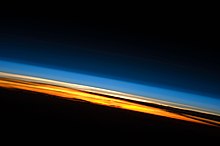Layers of the Atmosphere
 From Wikiversity - Reading time: 2 min
From Wikiversity - Reading time: 2 min

There are four layers in our atmosphere, each separated by temperature changes. These layers are:
- Troposphere
- Stratosphere
- Mesosphere
- Thermosphere
These 4 layers each have unique characteristics to each one of them. In this lesson, we will learn these layers one by one.
Troposphere
[edit | edit source]Distance: "The troposphere starts at Earth's surface and goes up to a height of 7 to 20 km (4 to 12 miles, or 23,000 to 65,000 feet) above sea level"[1]

This layer is the lowest layer of the Earth, the troposphere (trop-os-feer). This layer is where we, the humans, live in (and all the weather is at!). This layer contains nearly 90% of the atmosphere's total mass! Almost all of the Earth's water vapor, carbon dioxide, air pollution, clouds, weather and life forms live in. The word, "troposphere", literally means "change/turning ball", as the gases turn and mix in this layer. These gases mix due to the differences in air temperature and density.
Stratosphere
[edit | edit source]Distance: "The bottom of the stratosphere is around 10 km (6.2 miles or about 33,000 feet) above the ground at middle latitudes. The top of the stratosphere occurs at an altitude of 50 km (31 miles)"[2]

The layer above the Troposphere is known as the Stratosphere (strat-os-feer). Gases in the stratosphere are layered (why it has the prefix, "strato", meaning layered), the air is very thin (little moisture as well), and is extremely cold (lower stratosphere). Although the lower part of the stratosphere is cold, the heat in the stratosphere increases as altitude increases. This is because of the ozone layer in the upper part of the Stratosphere. The Ozone layer absorbs ultraviolet radiation from the sun, and as a result, warms up the air. This ozone layer is key to our safe living on Earth.
Mesosphere
[edit | edit source]Distance: "The mesosphere starts at 50 km (31 miles) above Earth's surface and goes up to 85 km (53 miles) high"[3]
Above the Stratosphere is the Mesosphere (mez-os-feer), the middle layer of the atmosphere (meso- meaning "middle"). This layer is the coldest layer (temperature decreases as altitude increases). Temperatures can be as low as -93 degrees Celsius at the top of the Mesosphere.
Thermosphere
[edit | edit source]Distance: "It extends from about 90 km (56 miles) to between 500 and 1,000 km (311 to 621 miles) above our planet"[4]

The uppermost atmosphere is called the Thermosphere (therm-os-feer). Here, the temperature again increases with altitude. This is because atoms of nitrogen and oxygen absorb high-energy solar radiation and give off thermal energy... this causes the temperature to increase up to 1,000 degrees Celsius.
Even though it may seem, it is actually not hot in the Thermosphere. Pay close attention to these details:
- Temperature is different from heat
- Temperature is the measure of the average energy of particles in motion. Thus, the thermosphere has particles moving very fast.
- Heat is the transfer of thermal energy between objects of different temperatures. Therefore, particles must touch one and another to transfer heat.
In the Thermosphere, it is has a low density--thus the particles in the Thermosphere usually don't collide, thus not giving off heat.
 KSF
KSF